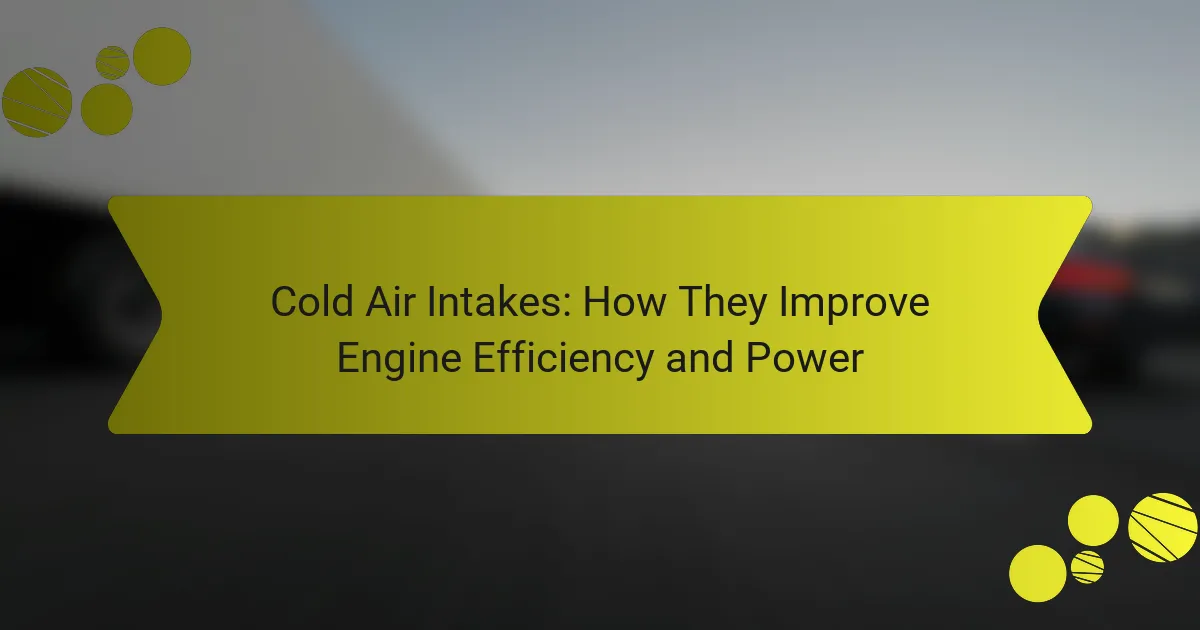Intercoolers significantly enhance engine performance by cooling compressed air before it enters the engine. This article explores the role of intercoolers, details various types such as air-to-air and air-to-water, and examines their impact on performance. Additionally, it addresses selection criteria, common challenges, and emerging trends in intercooler technology. Understanding these aspects can lead to improved vehicle efficiency and power output.

How do intercoolers function in automotive systems?
Intercoolers function by cooling the air compressed by the turbocharger or supercharger before it enters the engine. This process enhances engine performance and efficiency.
Intercoolers come in various types, including air-to-air and air-to-water. Air-to-air intercoolers use ambient air to cool the charged air, while air-to-water intercoolers utilize a water-cooling system.
The performance impact of intercoolers is significant. They reduce intake air temperatures, leading to denser air and improved combustion efficiency. This results in increased horsepower and torque, along with reduced engine knock.
In summary, intercoolers play a crucial role in automotive systems by optimizing air temperature, enhancing performance, and ensuring engine longevity.
What are the key components of an intercooler?
The key components of an intercooler include the core, end tanks, inlet and outlet pipes, and cooling fins. The core facilitates heat exchange, while end tanks manage airflow. Inlet and outlet pipes connect the intercooler to the turbocharger and engine. Cooling fins enhance heat dissipation, improving performance.
Why is heat exchange critical in performance vehicles?
Heat exchange is critical in performance vehicles because it enhances engine efficiency and prevents overheating. Intercoolers play a vital role in this process by cooling the air entering the engine, which increases its density and oxygen content. This results in improved combustion and power output.
There are several types of intercoolers, including air-to-air and air-to-water systems. Air-to-air intercoolers use ambient air to cool the intake charge, while air-to-water intercoolers utilize a liquid coolant for more effective temperature reduction. Each type has its unique attributes impacting performance, such as size, weight, and cooling efficiency.
The performance impact of intercoolers is significant. Properly sized and designed intercoolers can lead to a power increase of 10-20% by optimizing air intake temperatures. This enhancement allows vehicles to maintain higher performance levels under demanding conditions, such as racing or heavy towing.
Overall, effective heat exchange through intercoolers is essential for maximizing engine performance and longevity in high-performance vehicles.

Which types of intercoolers are most commonly used?
The most commonly used types of intercoolers are air-to-air, air-to-water, and liquid-to-liquid intercoolers. Air-to-air intercoolers are efficient and lightweight, making them popular for performance vehicles. Air-to-water intercoolers provide better cooling in compact spaces, while liquid-to-liquid intercoolers are used in high-performance applications for optimal temperature control. Each type impacts engine performance differently, influencing boost pressure and overall efficiency.
What are the differences between air-to-air and air-to-water intercoolers?
Air-to-air intercoolers use ambient air to cool intake air, while air-to-water intercoolers use water for cooling. Air-to-air systems are simpler and lighter, making them popular in many applications. In contrast, air-to-water systems offer better cooling efficiency, especially in high-performance settings. The choice depends on performance needs, space constraints, and weight considerations.
How do different intercooler designs affect performance?
Different intercooler designs significantly impact performance by influencing air temperature, density, and flow efficiency. Tube and fin intercoolers are lightweight and cost-effective, while bar and plate designs provide better thermal efficiency and durability.
| Intercooler Design | Airflow Efficiency | Cooling Capacity | Weight | Cost |
|———————|——————–|——————|———–|————|
| Tube and Fin | Moderate | Moderate | Light | Low |
| Bar and Plate | High | High | Heavy | Moderate |
| Air-to-Air | High | High | Moderate | Moderate |
| Air-to-Water | Very High | Very High | Heavy | High |
The choice of design affects turbocharged engine performance, with efficient intercoolers reducing the risk of knock and improving horsepower.

What impact do intercoolers have on engine performance?
Intercoolers significantly enhance engine performance by lowering intake air temperatures. This process increases air density, leading to improved combustion efficiency and power output. Additionally, intercoolers can prevent engine knock, allowing for higher boost levels and better overall engine reliability. High-performance vehicles often utilize air-to-air or air-to-water intercoolers to optimize these benefits.
How does an intercooler improve horsepower and torque?
An intercooler improves horsepower and torque by lowering the intake air temperature, which increases air density. Denser air allows for more oxygen to enter the engine, enhancing combustion efficiency. As a result, this leads to greater power output. Intercoolers can be air-to-air or air-to-water, with each type offering unique cooling efficiencies. The performance impact of an intercooler is significant, especially in turbocharged and supercharged engines, where maintaining optimal air temperature is crucial for maximizing engine performance.
What are the effects of intercooler efficiency on fuel consumption?
Intercooler efficiency significantly affects fuel consumption by enhancing engine performance and reducing intake temperatures. Higher efficiency leads to better air density, allowing for more fuel combustion. As a result, vehicles can achieve improved fuel economy, especially under high-load conditions. Efficient intercoolers can reduce fuel consumption by up to 10%, depending on the engine setup and driving conditions.

Which factors influence intercooler selection for specific vehicles?
Intercooler selection for specific vehicles is influenced by engine type, vehicle performance goals, space constraints, and ambient conditions. Engine type determines cooling needs; turbocharged engines typically require more efficient intercoolers. Performance goals dictate the intercooler’s size and design. Space constraints may limit options, while ambient conditions affect airflow and cooling efficiency.
What role does vehicle type play in intercooler choice?
Vehicle type significantly influences intercooler choice due to varying space, performance needs, and cooling requirements. Different vehicles, such as sports cars, trucks, and sedans, have distinct engine layouts and airflow dynamics. For example, a compact sports car may require a lightweight, high-efficiency intercooler to maximize performance, while a larger truck may need a robust intercooler to handle increased power and heat from towing. Additionally, factors such as mounting location, air intake design, and aesthetic considerations further dictate the appropriate intercooler type for each vehicle. Choosing the right intercooler ensures optimal engine performance and longevity.
How do climate conditions affect intercooler performance?
Climate conditions significantly impact intercooler performance by affecting air density and temperature. Higher ambient temperatures reduce cooling efficiency, while increased humidity can lead to heat soak. Cold climates can enhance intercooler function but may cause icing issues. Overall, optimal intercooler performance relies on maintaining suitable environmental conditions for effective heat exchange.

What are the common challenges associated with intercoolers?
Common challenges associated with intercoolers include heat soak, pressure drops, and limited space for installation. Heat soak occurs when the intercooler absorbs too much heat, reducing efficiency. Pressure drops can hinder airflow, impacting performance. Additionally, installation constraints can complicate design and accessibility. These factors can lead to suboptimal engine performance and increased maintenance needs.
How can intercooler placement impact vehicle dynamics?
Intercooler placement significantly influences vehicle dynamics by affecting airflow and weight distribution. Proper positioning enhances cooling efficiency, improving engine performance and response. For example, a front-mounted intercooler typically offers better airflow than a top-mounted one, leading to lower intake temperatures. Additionally, placement impacts vehicle balance; a poorly positioned intercooler can shift weight distribution, affecting handling and stability. As a result, optimizing intercooler placement is crucial for maximizing performance and maintaining vehicle dynamics.
What maintenance practices ensure optimal intercooler function?
Regular maintenance practices ensure optimal intercooler function. Key practices include checking for leaks, cleaning the intercooler, inspecting hoses and connections, and monitoring coolant levels.
1. Check for leaks: Examine the intercooler and surrounding components for any signs of fluid leaks.
2. Clean the intercooler: Remove dirt and debris to maintain airflow and heat exchange efficiency.
3. Inspect hoses and connections: Look for cracks or wear that could lead to pressure loss.
4. Monitor coolant levels: Ensure the cooling system is filled to the recommended level for effective temperature regulation.
These practices enhance the intercooler’s performance and longevity.

What are the emerging trends in intercooler technology?
Emerging trends in intercooler technology focus on efficiency, compact designs, and advanced materials. Manufacturers are adopting lightweight materials like carbon fiber and aluminum to enhance heat transfer while reducing weight.
Innovations include air-to-water intercoolers, which offer superior cooling efficiency over traditional air-to-air systems. Additionally, variable geometry intercoolers are gaining traction, allowing for dynamic adjustment of airflow based on engine demand.
Integration of smart sensors for real-time monitoring is also on the rise, enabling better performance management. These advancements aim to improve overall engine efficiency and reduce emissions, aligning with automotive industry sustainability goals.
How are advancements in materials improving intercooler efficiency?
Advancements in materials are significantly enhancing intercooler efficiency by improving thermal conductivity and reducing weight. New alloys and composites allow for better heat exchange, leading to lower intake temperatures. For instance, aluminum and advanced plastics are increasingly used to optimize performance while minimizing bulk. Enhanced surface treatments also promote greater heat dissipation, further boosting efficiency.
What innovative designs are shaping the future of intercoolers?
Innovative designs in intercoolers focus on efficiency, weight reduction, and enhanced cooling performance. Advanced materials like carbon fiber and aluminum alloys are being utilized to improve heat transfer. Additionally, compact designs and integrated systems optimize space and airflow, contributing to better overall vehicle performance. These innovations are essential for high-performance engines, where effective cooling directly impacts power output and reliability.
What are best practices for maximizing intercooler performance?
To maximize intercooler performance, ensure optimal airflow, maintain proper coolant levels, and regularly clean the intercooler. Upgrading to a larger or more efficient intercooler can significantly enhance cooling capacity. Additionally, consider using a high-performance fan to improve heat dissipation.



